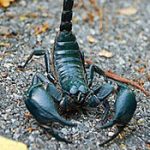Scorpions are predatory arthropod animals of the order Scorpiones within the class Arachnida. There are about 2,000 species of scorpions, found widely distributed south of about 49° N, except New Zealand and Antarctica. The northernmost part of the world where scorpions live in the wild is Sheerness on the Isle of Sheppey in the UK, where a small colony of Euscorpius flavicaudis has been resident since the 1860s. The word scorpion derives from Greek skorpios.
Scorpions have quite variable lifespans and the actual lifespan of most species is not known. The age range appears to be approximately 25 years (25 years being the maximum reported life span in the species Hadrurus arizonensis). Lifespan of Hadogenes species in the wild is estimated at 25-30 years.
Scorpions prefer to live in areas where the temperatures range from 20 °C to 37 °C (68 °F to 99 °F), but may survive from freezing temperatures to the desert heat.[8][9] Scorpions of the genus Scorpiops living in high Asian mountains, bothriurid scorpions from Patagonia and small Euscorpius scorpions from middle Europe can all survive winter temperatures of about -25 °C. In Repetek (Turkmenistan) there live seven species of scorpions (of which Pectinibuthus birulai is endemic) in temperatures which vary from 49,9 °C to -31 °C.
They are nocturnal and fossorial, finding shelter during the day in the relative cool of underground holes or undersides of rocks and coming out at night to hunt and feed. Scorpions exhibit photophobic behavior, primarily to evade detection by their predators such as birds, centipedes, lizards, mice, possums, and rats.
Scorpions are opportunistic predators of small arthropods and insects. They use their chelae (pincers) to catch the prey initially. Depending on the toxicity of their venom and size of their claws, they will then either crush the prey or inject it with neurotoxic venom. This will kill or paralyze the prey so the scorpion can eat it. Scorpions have a relatively unique style of eating using chelicerae, small claw-like structures that protrude from the mouth that are unique to the Chelicerata among arthropods. The chelicerae, which are very sharp, are used to pull small amounts of food off the prey item for digestion. Scorpions can only digest food in a liquid form; any solid matter (fur, exoskeleton, etc) is disposed of by the scorpion.

